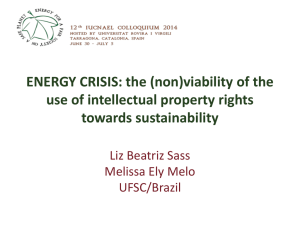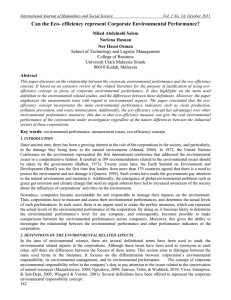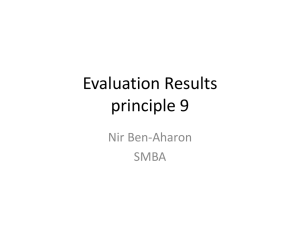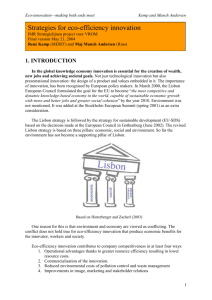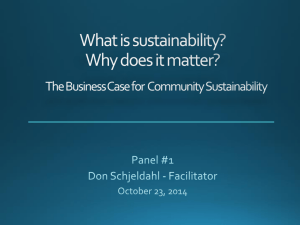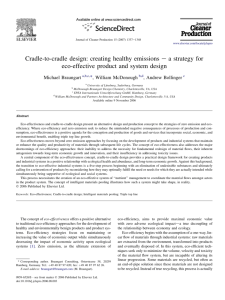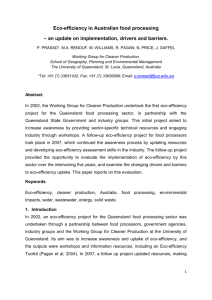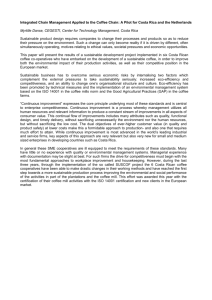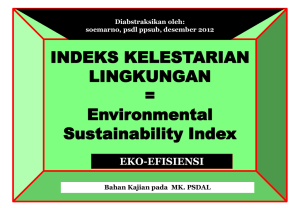PowerPoint-Präsentation
advertisement
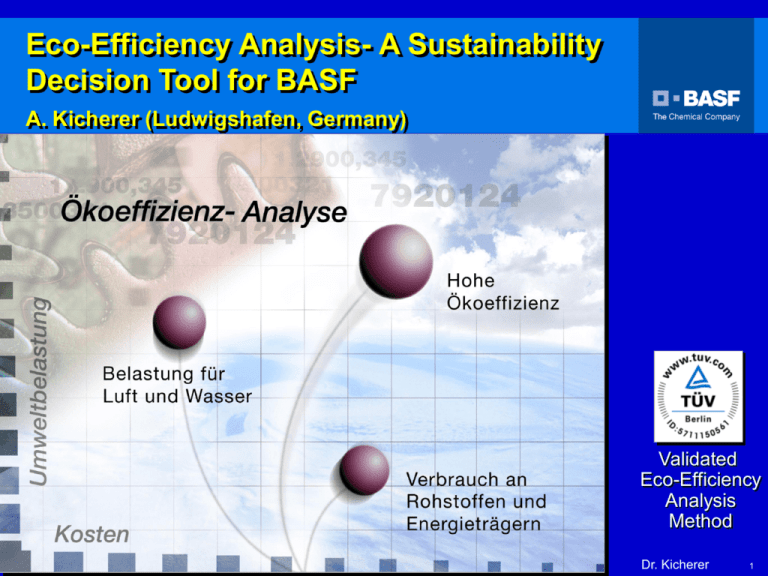
Eco-Efficiency Analysis- A Sustainability Decision Tool for BASF A. Kicherer (Ludwigshafen, Germany) Validated Eco-Efficiency Analysis Method Eco-Efficiency Dr. Kicherer 1 The Ludwigshafen site BASF’s largest production site worldwide 8,000 sales products 2,000 buildings 70 miles of roads 150 miles of rail track 35,000 people (83,000 worldwide) Eco-Efficiency Dr. Kicherer 2 Sustainable Development is based on three Pillars Sustainable Development Ecology Society Economy Eco-EfficiencyAnalysis Eco-Efficiency SEEbalance®Analysis* * being developed3 Dr. Kicherer What is Eco-Efficiency Analysis? Method for the comprehensive assessment of products and processes. Ecological and economic aspects are given equal weight in assessments. The products are analyzed from the angle of the end customer. (Future) scenarios and effects of various action options are presented. Eco-efficiency analysis is a standard tool in the BASF Group; more than 240 analyses have been carried out. Eco-Efficiency Dr. Kicherer 4 Project Furniture Clear Coat Eco-Efficiency Dr. Kicherer 5 Alternative Systems for Furniture Clear Coat Determine demandspecific benefit Define comparable products NC-lacquer (established technology) Coating of 1 m² furniture surface PUR-lacquer (market leader) UV-powder (new technology) UV-water (new technology) Eco-Efficiency Dr. Kicherer 6 Further Development of UV-Water Technology Improves the Eco-Efficiency User spezific benefit: Coating of 1 m² furniture surface Environ. Impact (normalized) 0,3 UV-water High eco-efficiency Further development UV-powder 1,0 PURlacquer NC-lacquer Circle size: Market share in Europe Low eco-efficiency 1,7 1,7 1,0 0,3 Total costs (normalized) Eco-Efficiency Dr. Kicherer 7 Communication BASF-Coatings develops new, environmentaly friendly lacquers, even if they are innitially somewhat more expensive. Together with customers improvements can be initiated which reduces the costs. The eco-efficiency analysis can easily communicate these future trends and improvements. Eco-Efficiency Dr. Kicherer 8 Assessment Factors of the society 20% 20% Energy consumption Raw material consumption Air Air emission emissions 50% 50% Greenhouse warming potential 50% Ozone depletion potential 20% Photochemical ozone creation potential 20% Acidification potential 10% 10% Area requirement 20% Emissionen Emissions Emissions 20% Toxicity potential 10% Risk potential Eco-Efficiency Water emissions 35% Wastes 15% Dr. Kicherer 9 Acceptance of the Method by Stakeholders, NGOs and Science ... ...Basically, the large number of indicators used in eco-efficiency analysis make relatively reliable statements possible ... Dr. Reinhard Loske Mitglied des Deutschen Bundestages Umweltpolitischer Sprecher Bündnis 90/DIE GRÜNEN Öko-Institut e.V.; Bereiche Chemie und Umweltrecht Eco-Efficiency ......Politically, it is worth considering how this tool can find wider application....... ....The sensitivity considerations carried out in the eco-efficiency analysis make sense and provide good orientation as regards further ecological and economic optimizations.... Dr. Kicherer 10 ... and the whole World. Pilot project with UNEP/UNIDO to improve the eco-efficiency of Moroccan dyehouses Assessed since 2002 as one of the world’s most sustainable chemical companies, partly as the result of the development of eco-efficient products Eco-Efficiency Dr. Kicherer 11 What does BASF use Eco-Efficiency Analysis for? Internal Strategy Research/product development • Decisions on investments • Prioritization of research projects Politics Marketing • Discussion with opinion makers in political decisions • External customers optimize their products and processes with ecoefficiency analyses External Eco-Efficiency Dr. Kicherer 12 Consequences of Eco-Efficiency Analyses Environmental Impact (normalized) low Depending on the position of the analysed product, different strategic 1,0 recommendations are given. bring to market! reduce costs! develop alternatives! reduce environmental impact! high high Eco-Efficiency 1,0 costs (normalized) low Dr. Kicherer 13 Examples for More Profit Created Through Eco-Efficiency Analysis An eco-efficiency project with a coatings customer resulted in a additional business of about 400.000 € per year. An annual saving of 100.000 € could be obtained by an eco-efficiency analysis for transportation of chemicals. The eco-efficiency analysis with an American customer in the aggregate sector increased the annual sales of 2.200.000 US$ by about 10% The ROI is therefore much smaller than 1 year Eco-Efficiency Dr. Kicherer 14 Why is Eco-Efficiency Successful? Quantitative results with a clear assessment Simple and impressive illustration of the results Scenario- and sensitivity analysis Short timeframe (2 - 6 month) Low costs for the analysis Combination of LCA with LCC Eco-Efficiency Dr. Kicherer 15 The Eco-Efficiency Team: Our Homepage: http://www.oekoeffizienzanalyse.de Eco-Efficiency Dr. Kicherer 16 Back-up slides Eco-Efficiency Dr. Kicherer 17 The detailed Results can be read off in the Ecological Fingerprint Energy consumption Solution, electrochemically 1,0 Material consumption Solution, 40% 0,5 Emissions Granules, synthetically 0,0 Granules, biotechnologically Risk potential Eco-Efficiency Toxicity potential Powder from plants Dr. Kicherer 18 Raw material costs are normally small compared to total costs DM/m² thermal insulation system House Insulation Systems 160 140 120 Disposal 100 Transports 80 Adhesive and plaster 60 Aluminium edges 40 handscrafts 20 Insulation material 0 Neopor Eco-Efficiency Styropor Mineralfiber Dr. Kicherer 19 Are you interested? How can you proceed? Get in touch with us. (http://www.oekoeffizienzanalyse.de) We will provide you with a tailor-made proposal. Your own efforts to determine the input data are relatively low. The total costs are between € 20,000 and 30,000 (depending on the complexity). Eco-Efficiency Dr. Kicherer 20 Opportunities for Marketing and Sales Direct comparison with your competitor Show your customer the superiority of your product Label, broschures, publications Comparison of your customers competitors Demonstrate your customer the superiority of his product. Common communication, label Help your customer to optimize his processes Added value increases customer relation Eco-Efficiency Dr. Kicherer 21 Development of environmental protection in companies Production inte- Product integrated End-of-pipe grated environenvironmental technology mental protection protection 80‘s e.g. Waste water treatment plants, Eco-Efficiency 90‘s e.g.: Residual materials of a procedure are raw materials of another Sustainable Development 00‘s e.g.: Green Engineering Social, economical and ecological aspects of products Dr. Kicherer 22 Production-related waste and emissions Per metric ton of BASF Aktiengesellschaft products Total: 28.2 kg Air Water 3.6 kg 1.8 kg Landfill 22.8 kg Total: 6.7 kg 1.8 kg 1.0 kg 3.9 kg 1991 Eco-Efficiency 2001 Dr. Kicherer 23 Jeans Dyeing Project Eco-Efficiency Dr. Kicherer 24 Alternative Systems for Indigo dying Determine demandspecific benefit Select BASF product Define comparable products Indigo powder from plants Dyeing of blue synthetic denim for the indigo production of granules 1000 jeans biotechnological Indigo granules synthetical indigo solution,40%, synthetical lndigo solution, 40%, electrochemical dyeing process Eco-Efficiency Dr. Kicherer 25 In the Eco-Efficiency Portfolio, the Environmental Impact is plotted against the Costs Environ. Impact (normalized) 0,4 High eco-efficiency Electrochemical Benefit: 1.000 jeans dyed with indigo Solution 1,0 Biotechnological Granules Plants 1,6 Low eco-efficiency 1,6 1,0 0,4 Total costs (normalized) Eco-Efficiency The portfolio is based onto a principle idea of Schaltegger and Sturm 1992 Dr. Kicherer 26 Consequences of the Analysis Construction of a plant for the production of 40% indigo solution (beginning production at the end of 1999) Increased R&D expenditure for the electrochemical process (construction of a pilot plant) Communication with customers and professional circles Success of the measures: Increase of the market share from 2% (1999) to approximately 40% (2002) Eco-Efficiency Dr. Kicherer 27
